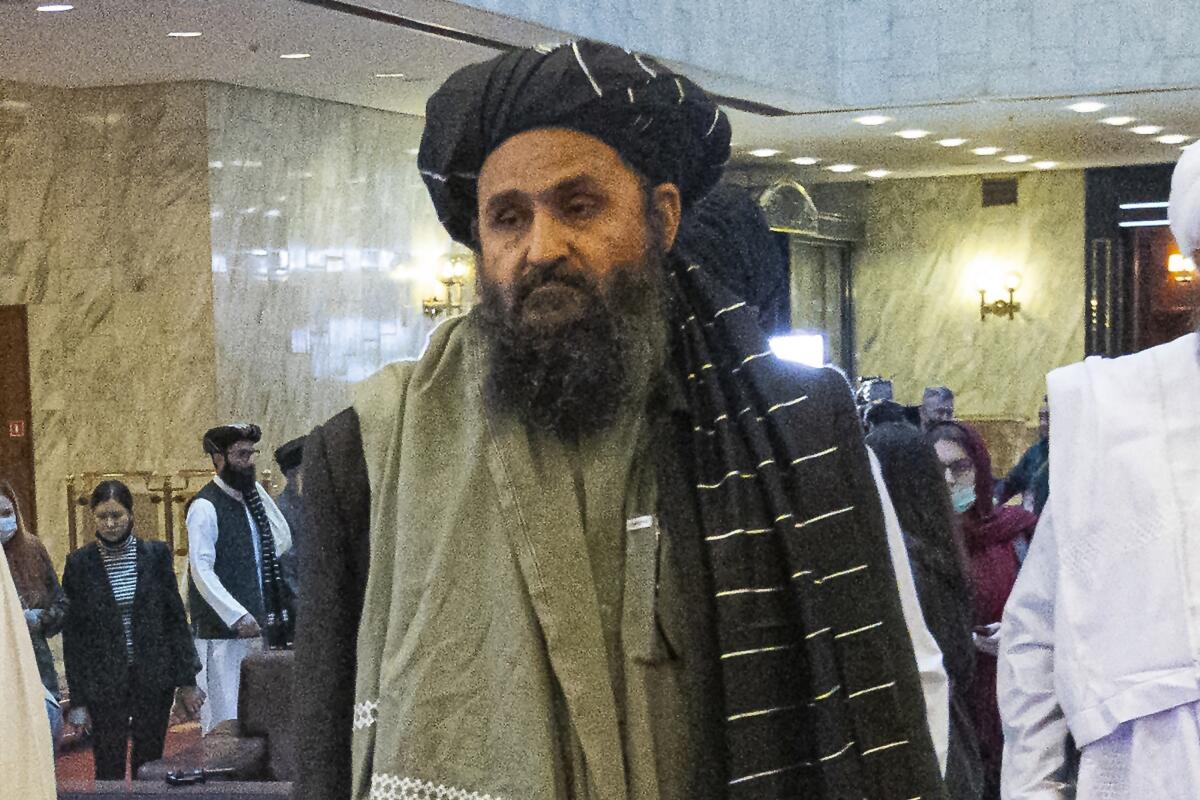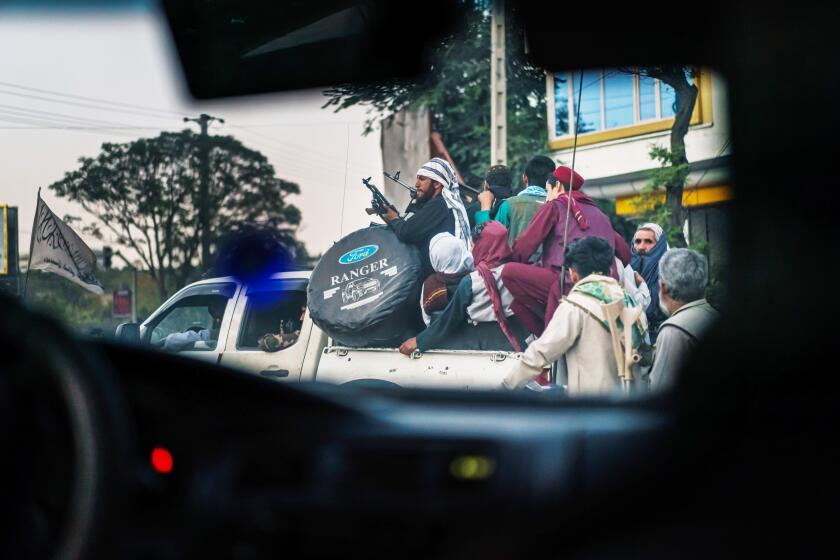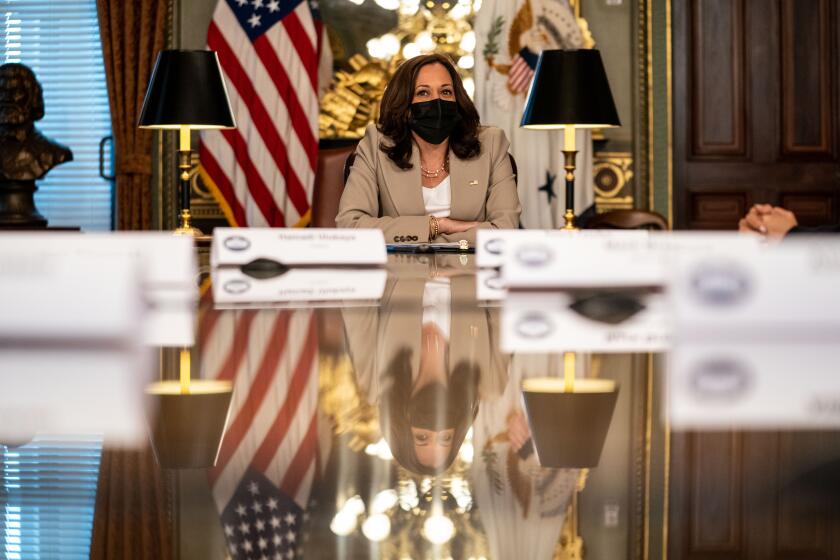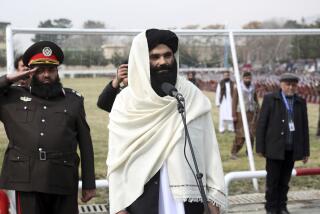Once in prison, now in power, a mullah embodies the Taliban’s stunning comeback

- Share via
The Taliban’s top political leader, who made a triumphant return to Afghanistan this week, battled the U.S. and its allies for decades but then signed a landmark peace agreement with the Trump administration.
Mullah Abdul Ghani Baradar is now expected to play a key role in negotiations between the Taliban and officials from the Afghan government that the militant group deposed in its blitz across the country. The Taliban says it seeks an “inclusive, Islamic” government and claims to have become more moderate since it last held power from 1996 to 2001.
But many remain skeptical, and all eyes are now on Baradar, who has said little about how the group will govern but who has proved pragmatic in the past.
Baradar’s biography charts the arc of the Taliban’s journey as an Islamic militia that battled warlords during Afghanistan’s 1990s civil war, ruled the country for five years using a strict interpretation of Islamic law and then waged a two-decade insurgency against the U.S. His trajectory also sheds light on the Taliban’s complicated relationship with neighboring Pakistan.
Baradar is the only surviving Taliban leader to have been personally appointed deputy by the late Taliban commander Mullah Mohammed Omar, giving Baradar near-legendary status within the movement. And he is far more visible than the Taliban’s current supreme leader, Maulawi Hibatullah Akhunzada, who is believed to be in hiding in Pakistan and only releases occasional statements.
Protesters in Jalalabad who tried to raise the Afghan national flag in place of the Taliban’s were dispersed by fighters wielding weapons.
On Tuesday, Baradar landed in the southern Afghan city of Kandahar, the birthplace of the Taliban movement he helped found in the mid-1990s. Ending 20 years of exile, he was thronged by well-wishers as he stepped off a Qatari government aircraft and drove off in a convoy.
Baradar, who is in his early 50s, was born in southern Oruzgan province. Like others who would eventually become Taliban leaders, he joined the ranks of the CIA- and Pakistan-backed mujahedin to fight against the Soviet Union during its decade-long occupation of Afghanistan, which ended in 1989.
In the 1990s, the country slid into civil war, with rival mujahedin factions battling one another and carving out fiefdoms. Warlords set up brutal protection rackets and checkpoints at which their forces shook down travelers to fund their military activities.
The vice president says she was the last person in the room to advise President Biden when he decided earlier this year to pull out from Afghanistan.
In 1994, Omar, Baradar and others founded the Taliban, which means “religious students.” The group mainly consisted of clerics and young, pious men, many of whom had been driven from their homes and had known only war. Their austere interpretation of Islam unified their ranks and set them apart from the notoriously corrupt warlords.
Baradar fought alongside Omar as he led the Taliban through its seizure of power in 1996 and its return to an insurgency following the 2001 U.S.-led invasion.
During the group’s five-year rule, the president and governing council were based in Kabul. But Baradar spent most of his time in Kandahar and did not have an official government role.
After the U.S. invasion, Baradar, Omar and other Taliban leaders fled to neighboring Pakistan. In the ensuing years, the Taliban was able to organize a potent insurgency based in rugged and semiautonomous tribal areas along the border. Baradar was arrested in the southern Pakistani city of Karachi in 2010 in a joint raid by the CIA and Pakistan’s counter-terrorism forces.
At the time, he had been making peace overtures to then-Afghan President Hamid Karzai, but the U.S. was intent on military victory, and it appeared that Pakistan wanted to ensure control over any political process. Baradar’s removal empowered more radical leaders within the Taliban who were less open to diplomacy.
Karzai later confirmed the overtures to the Associated Press and said he had twice asked the Americans and the Pakistanis to free Baradar but was rebuffed. Baradar himself refused an offer of release in 2013, apparently because the U.S. and Pakistan conditioned it on his cooperation.
Karzai, who is now involved in talks with the Taliban about shaping the next government, could once again find himself negotiating with Baradar.
By 2018, the Taliban was in de facto control over much of Afghanistan’s countryside. The Trump administration, looking for a way out of America’s longest war, persuaded Pakistan to release Baradar that year and began pursuing peace talks with the Taliban.
Baradar led the Taliban’s negotiating team in Qatar through several rounds of those talks, culminating in a February 2020 peace agreement. He also met with then-Secretary of State Michael R. Pompeo.
Under the deal, the Taliban agreed to halt attacks on international forces and prevent Afghanistan from again becoming a haven for terrorist groups in return for a full U.S. withdrawal, now planned for the end of the month.
Last week, the Taliban pushed into the country’s cities, seizing nearly all of the country in matter of days and rolling virtually unopposed into the capital, Kabul.
News Alerts
Get breaking news, investigations, analysis and more signature journalism from the Los Angeles Times in your inbox.
You may occasionally receive promotional content from the Los Angeles Times.
In his first comment after the capture of Kabul on Sunday, Baradar acknowledged his surprise, saying that “it was never expected that we will have victory in Afghanistan.”
Wearing a black turban and vest over a white robe, the bespectacled Baradar looked straight into the camera.
“Now comes the test,” he said. “We must meet the challenge of serving and securing our nation, and giving it a stable life going forward.”
More to Read
Sign up for Essential California
The most important California stories and recommendations in your inbox every morning.
You may occasionally receive promotional content from the Los Angeles Times.












